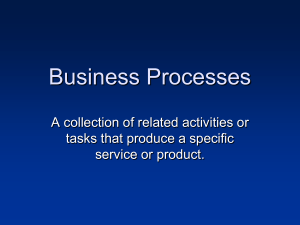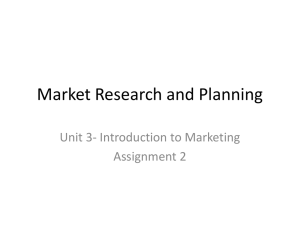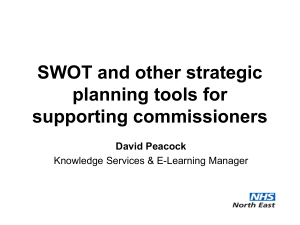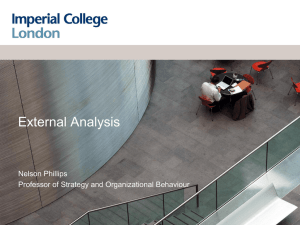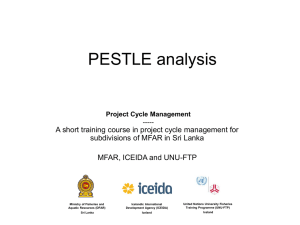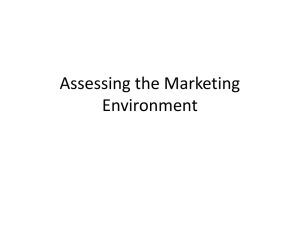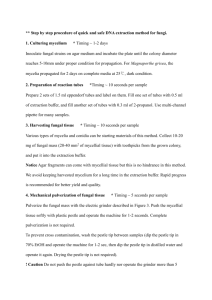CIPD pestle analysis
advertisement
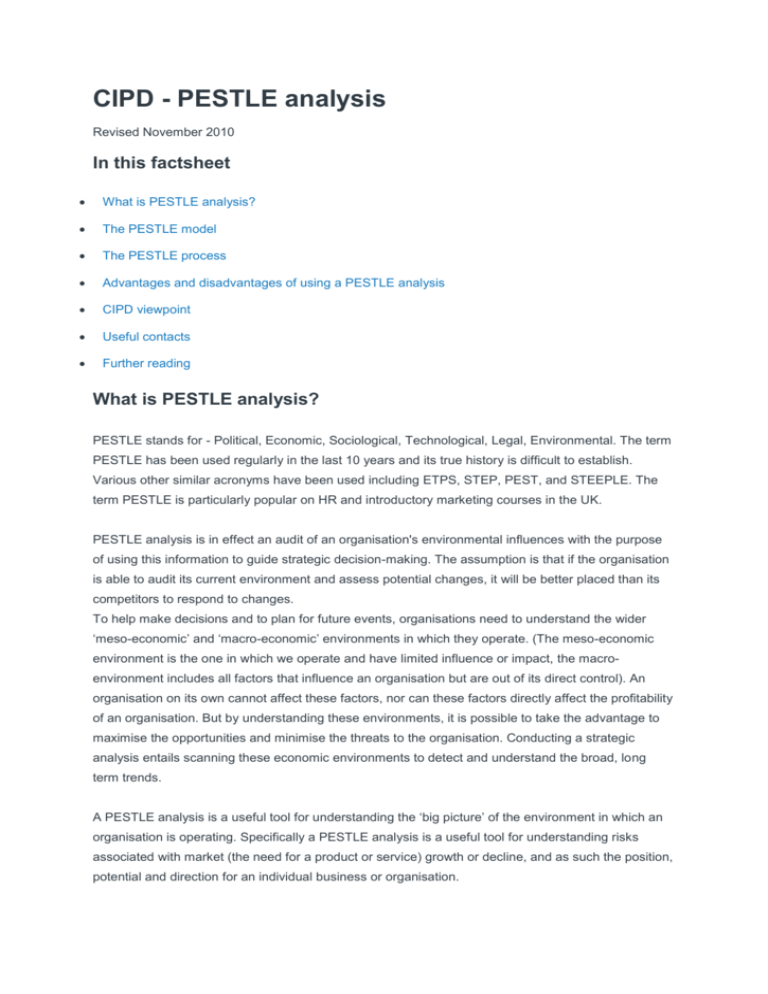
CIPD - PESTLE analysis Revised November 2010 In this factsheet What is PESTLE analysis? The PESTLE model The PESTLE process Advantages and disadvantages of using a PESTLE analysis CIPD viewpoint Useful contacts Further reading What is PESTLE analysis? PESTLE stands for - Political, Economic, Sociological, Technological, Legal, Environmental. The term PESTLE has been used regularly in the last 10 years and its true history is difficult to establish. Various other similar acronyms have been used including ETPS, STEP, PEST, and STEEPLE. The term PESTLE is particularly popular on HR and introductory marketing courses in the UK. PESTLE analysis is in effect an audit of an organisation's environmental influences with the purpose of using this information to guide strategic decision-making. The assumption is that if the organisation is able to audit its current environment and assess potential changes, it will be better placed than its competitors to respond to changes. To help make decisions and to plan for future events, organisations need to understand the wider ‘meso-economic’ and ‘macro-economic’ environments in which they operate. (The meso-economic environment is the one in which we operate and have limited influence or impact, the macroenvironment includes all factors that influence an organisation but are out of its direct control). An organisation on its own cannot affect these factors, nor can these factors directly affect the profitability of an organisation. But by understanding these environments, it is possible to take the advantage to maximise the opportunities and minimise the threats to the organisation. Conducting a strategic analysis entails scanning these economic environments to detect and understand the broad, long term trends. A PESTLE analysis is a useful tool for understanding the ‘big picture’ of the environment in which an organisation is operating. Specifically a PESTLE analysis is a useful tool for understanding risks associated with market (the need for a product or service) growth or decline, and as such the position, potential and direction for an individual business or organisation. A PESTLE analysis is often used as a generic 'orientation' tool, finding out where an organisation or product is in the context of what is happening outside that will at some point affect what is happening inside an organisation. The six elements form a framework for reviewing a situation, and can also be used to review a strategy or position, direction of a company, a marketing proposition, or idea. The PESTLE model The PESTLE model provides users with a series of headings under which users can brainstorm or research key factors: Political: what is happening politically in the environment in which you operate, including areas such as tax policy, employment laws, environmental regulations, trade restrictions and reform, tariffs and political stability. Economic: what is happening within the economy, for example; economic growth/ decline, interest rates, exchange rates and inflation rate, wage rates, minimum wage, working hours, unemployment (local and national), credit availability, cost of living etc. Sociological: what is occurring socially in the markets in which you operate or expect to operate, cultural norms and expectations, health consciousness, population growth rate, age distribution, career attitudes, emphasis on safety, global warming. Technological: what is happening technology-wise which can impact what you do, technology is leaping every two years, how will this impact your products or services, things that were not possible five years ago are now mainstream, for example mobile phone technology, Web 2.0, blogs and micro-blogs (Twitter), social networking websites. New technologies are continually being developed and the rate of change itself is increasing. There are also changes to barriers to entry in given markets, and changes to financial decisions like outsourcing and insourcing. Legal: what is happening with changes to legislation. This may impact employment, access to materials, quotas, resources, imports/ exports, taxation etc. Environmental: what is happening with respect to ecological and environmental issues. Many of these factors will be economic or social in nature. The PESTLE process Before starting a PESTLE analysis it is important to think through the process that is going to be followed. Steps include: Decide how the information is to be collected and by whom (a team approach is much more powerful than one person’s view). Identify appropriate sources of information. Gather the information - it is useful to use a template as the basis for exploring the factors and recording the information. An example of such a practical and ready-to-use template created to accompany this factsheet can be found on the RapidBI website. o Go to the template Analyse the findings. Identify the most important issues. Identify strategic options. Write a discussion document. Disseminate and discuss the findings. Decide which trends should be monitored on an ongoing basis and what actions need to be taken. PESTLE analysis tips Some useful tips for carrying out a PESTLE analysis include: DO get other people involved to gain multiple perspectives. DO exploit any expertise and resources that are already available within the organisation. DO use PESTLE analysis in conjunction with other techniques, such as SWOT analysis (standing for Strengths, Weaknesses, Opportunities, Threats - see our factsheet for more information), Porter's five forces (see Useful links and Further reading below), competitor analysis or scenario planning etc. o Go to our SWOT analysis factsheet DO incorporate your analysis within an ongoing process for monitoring changes in the business environment. DON’T do this in isolation - a more effective result is obtained with multiple views. DON’T jump to conclusions about the future based on the past or the present. DON’T get bogged down in collecting vast amounts of detailed information without analysing and understanding your findings appropriately. When to use a PESTLE analysis PESTLE analysis can be used for business and strategic planning, marketing planning, organisational change, business and product development and research reports. It can also be used from a departmental or individual perspective to look at what you deliver, to whom and how you do it. To be effective a PESTLE needs to be undertaken on a regular or ongoing basis. Organisations that regularly and systematically do analyses often spot trends before others, thus providing competitive advantage. Business planning A PESTLE analysis is a useful document to have available at the start of a business planning process. It can provide the management team with background and context information about targets towards growth, new product development and brand positioning. The opportunities and threats identified can be fed into a SWOT process and strategies identified to avoid or minimise the impact of the threats, and equally strategies employed to build on the opportunities presented. Marketing planning As with business planning, a PESTLE analysis provides the essential element of ‘climate’ within a situation analysis phase of the marketing planning process. Product development It is often said that there are few ‘bad products’ but lots of wrong times and wrong places. As a PESTLE analysis provides a view of what is occurring in the external world, this will help when making the decision to enter or leave an area of product development. For example, portable tape recorders are excellent devices, but a PESTLE analysis might show that socially and technologically MP3 technology is more acceptable. Equally, from an environmental point of view the manufacture of tapes requires the use of heavy chemicals and would be increasingly taxed and rejected by society. Organisational change When looking at changing one function or department a PESTLE analysis can be a powerful tool for understanding the context in which the change is occurring and the potential areas of focus. Best used in association with a SWOT analysis, a PESTLE will provide information about potential opportunities and threats around labour changes, for example skills shortages. Using the PESTLE to look at factors outside the function but still inside the organisation can highlight factors such as: political: who is in what position, their power, vision, goals and directions etc. economic: financial implications, productivity etc. social: what is and is not acceptable within the culture technological: new computer systems or other new technology legal: changes to employment law, recruitment, visas etc. environmental: the space available, what can or cannot be moved where etc. In this situation, a PESTLE analysis can be thought of more as an audit. It is best used at the data capture phase as part of a pre-planning process of any strategic intervention. While using the tool internally can add some value, it will focus on factors which can be changed (that is, they are in the control of the organisation) if not the function concerned. So while it may be a useful framework, it should be used with caution in this context. Research reports A PESTLE analysis can also be used as a framework for looking outside the organisation to hypothesise what may or may not happen. It is a useful framework to use to ensure that some of the basic factors are not overlooked or ignored. It may be used in a similar way to business planning – but the application of the data is different. Advantages and disadvantages of using a PESTLE analysis There are a number of advantages and disadvantages associated with using a PESTLE analysis: Advantages include: It is a simple framework. It facilitates an understanding of the wider business environment. It encourages the development of external and strategic thinking. It can enable an organisation to anticipate future business threats and take action to avoid or minimise their impact. It can enable an organisation to spot business opportunities and exploit them fully. Disadvantages include: Some users over simplify the amount of data used for decisions – it is easy to use scant data. To be effective this process needs to be undertaken on a regular basis. The best reviews require different people being involved, each having a different perspective. Access to quality, external data sources can be time consuming and costly. The pace of change makes it increasingly difficult to anticipate developments that may affect an organisation in the future. The risk of capturing too much data is that it may make it difficult to see the wood for the trees and lead to ‘paralysis by analysis’. The data used in the analysis may be based on assumptions that subsequently prove to be unfounded (good and bad). CIPD viewpoint It is important for organisations to analyse the environment in which they operate, to help them make effective strategic decisions. The PESTLE analysis is an effective and structured way of thinking through this analysis. Using a structure such as PESTLE helps to ensure that any analysis is kept broad and does not focus on one area of the environment too narrowly. Using a PESTLE analysis can also be a useful way of getting opinions and contributions from a range of people, especially if it is used in a group brainstorm activity. A PESTLE analysis can be particularly effective when used with other analysis tools such as SWOT. Useful contacts RapidBI PEST / PESTLE analysis tool and template Prime Minister’s Strategy Unit ‘Strategy survival guide’ Thames Valley University e-learning unit on PESTLE Wikipedia on Porter’s Five Forces Further reading Books and reports PIERCE, C. (2001) The effective director: the essential guide to director and board development. London: Kogan Page. TURNER, S. (2002) Tools for success: a manager’s guide. London: McGraw Hill. MORRISON, M. (forthcoming) SWOT and PESTLE and other diagnostic tools [provisional title]. Putney: Intelligent Press. Visit the CIPD Store to see all our priced publications currently in print. Journal articles GRUNDY, T. (2006) Rethinking and reinventing Michael Porter's five forces model. Strategic Change. Vol 15, No 5, August. pp213-229. CIPD members can use our online journals to find articles from over 300 journal titles relevant to HR. Members and People Management subscribers can see articles on the People Management website. This factsheet was written by Mike Morrison FCIPD, Managing Director of RapidBI, a company specialising in organisational development tools and processes, and revised by Kathy Daniels, FCIPD, HR Consultant.

